While Méri (of agulhas da méri) was vacationing in America, she mailed to me a gorgeous book on hand embroidery traditions in Portugal. The book is titled Bordado de Guimarães, and the text is in Portugues with an English translation. I haven’t finished reading the book yet, but I’m enjoying it so much and am completely enchanted with the needlework therein, that I had to show you some bits of the book! If you like reading about and trying regional embroidery techniques, this book may very well be worth trying to track down!
The first thing that struck me about Guimarães Embroidery from Portugal is the dimensional quality of the work.
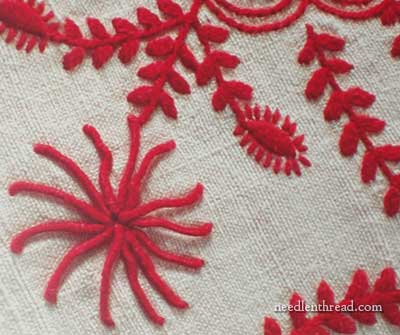
In much of it, you will see a consistent use of the bullion knot. And many of the bullions are really long! Méri mentioned this in the letter that accompanied her gift, but I didn’t understand how extensively the bullion knot is used until I started reading the book.
Clusters of bullion knots, combined with drawn thread work in some cases and simple surface embroidery in others, populate the surface of clothing, household linens, and other items of needlework in this style of embroidery.
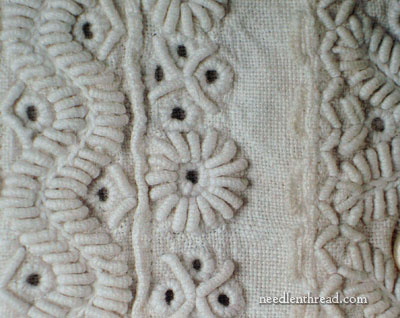
The rich dimension created by the use of this stitch contrasts sharply with another form of embroidery from a different region in Portugal, Castelo Branco. The embroidery of Castelo Branco, Portugal, is worked with a variety of rich colors, in flat silks, and with little dimension to the stitches themselves. I wrote about this type of embroidery a while ago, when Méri sent me a magazine on the subject. So, within about 215 miles of each other in Portugal, we can find two traditions of embroidery that are almost complete opposites! This fascinates me! In many areas of the world, this is the case, that within a relatively short distance we find a variety of different traditions in needlework. Here in America, we do not really have this rich and diverse history in the needle arts, so it is quite a pleasure to be able read and learn about the topic in the books Méri has sent! (Thank you, Méri!)
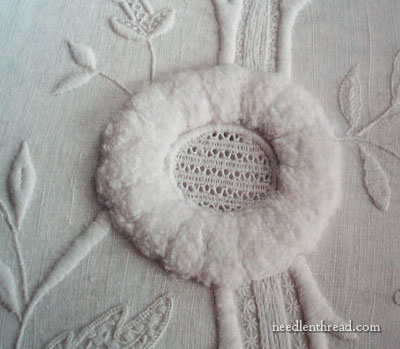
The embroidery of the Guimarães region employs other stitches besides the bullion knot, but it seems that, overall, the trademark of this region’s embroidery is dimension. This is a flower in the center of a monogram – the embroidery is very fine, and it is set off in contrast to this dimensional element in the center of the monogram.
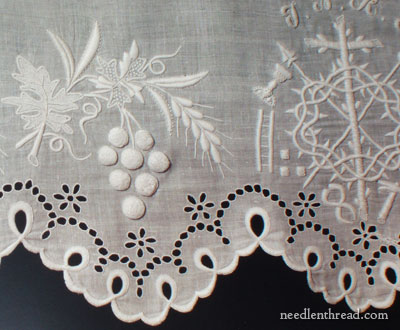
Even the very fine embroidery used on altar linens displays the dimensional touch! I love the grapes in this piece.
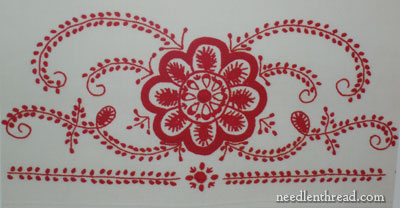
The overall look of the colored embroidery from this region is somewhat “folk” or “rustic.” Elaborate designs of bold flowers and vines all worked in red are common.
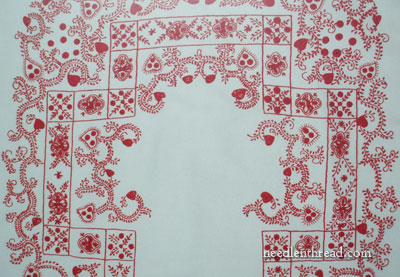
Household linens are decorated with folk motifs – the simple heart, tulip, flower, vines and dots – sometimes in elaborate and beautiful combinations.
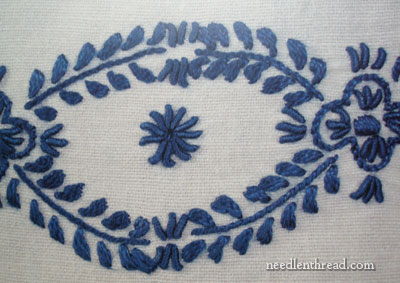
Sometimes, the stitching is done in blue.
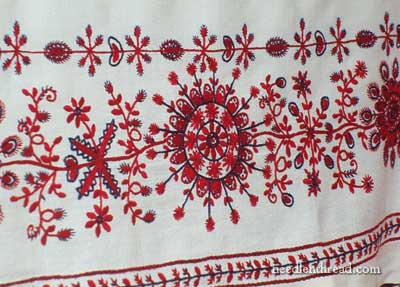
And sometimes, in both red and blue.
Needless to say, I’m enjoying the exploration of this book! Thank you, Méri!
It’s always fun to learn new techniques, but it’s equally as nice to know something about the traditions behind the techniques, don’t you think? Do you have any particular regional embroidery traditions that are listed among your favorite needlework topics? Would you happen to know of any good resources for information on various regional embroidery techniques throughout the world? If this is a topic that interests you and you have some resources to share, please feel free to leave a comment!







I’m dazzled – you always find the most interesting things – and always things that get me thinking – hmmmm – wouldn’t that look good on…. Thanks so much
Many years ago, DMC published a series of different embroideries. I’m lucky enuf to have the “CZECHO-SLOVAKIAN EMBROIDERIES”,1973 New Edition (Revised). Several years ago I wrote to the company (e-mailed) and asked if there was any chance of them doing reprints. I received an “NO” answer kinda like I had the gall to even ask. In looking at the back page of my copy, I find that they issued several others, among which I would love to have the “Bulgarian”, “Morocco” and “Yugoslavian” embroidery books. So, YES! I’m interested in more, more, more. Hugs to you, Judyth
Mary I have been following you for quite sometime will it be possible for you to give us some patterns with suggested stitches from different parts of the globe …….those who want to experiment on embroideries of different parts of the world will have an idea and also it will help those who do not have much access to such facilities as getting books through mail order like in Palestine.
I don’t know if this is the same book, but I found this downloadable PDF book with the same title at:
http://www.bordadodeguimaraes.pt/site/uk/index.php?pag=publicacoes
(Click on the little ‘book’ near the upper right hand corner where it says ‘Click to View’.)
You may, or may not, know about this beautiful, creative, and very addictive embroidery but check out the website http://www.brazilian-dimensional-embroidery.org and see the variety of stitches used in this art and how creative you can be using the variety of different stitches and then advance into combining the stitches together to make really dimensional flowers, critters, etc. It’s so much FUN!
Hi, All – Glad you like the book. Yes, Margaret – that’s the same book at the website link you provided! The “real” book is a bit better formatted, and the photos are clearer – but the online resource is great to have if you can’t find the book in print form. Thanks!
Hi, Jan – yes, Brazilian embroidery is quite beautiful! I’ve written a bit about it here on Needle ‘n Thread, but not a whole lot. I’ve worked one Brazilian embroidery piece a long time ago, and one of these days I’d like to re-visit the technique. A reader up in MA has kindly agreed to put together some photos from her BE group, so hopefully, I’ll be able to post something a bit more extensive about the technique soon.
Thanks for your comments!
thankes it is vrey fun
Thank you for this lovely post. I definitely must search out this book. The embroidery is stunning and I love learning about the differences and origins of various stitching.
Hi Mary
The large fuzzy flower in the middle of the monogram would that be done with turkey stitch then cut and fluffed?
Hugs
fredaB
Some of this looks very like Mountmellick
Thanks for showing us yet another regional embroidery. I love the motifs used… Beautiful
yes! White, blu and red, the colours of the embroidery of Guimarães and other portuguese towns. In my blog I put a work I made thinking of the embroidery of my country! Glad You like it too.
Mary, the flower in the center of the monogram looks puffy and fluffy; is it because of the stitch or the thread used? What is the name of the stitch and/or thread? Meri’s book is really beautiful.
Thank you,
🙂
I’m so glad you like the book, Mary!
I have forgotten to refer that link to a PDF download. I think I referred it last year when I’ve talked about this same book in my blog.
I just got this book only at this Museum in Guimaraes http://masampaio.imc-ip.pt/en-GB/Default.aspx
but can’t find any on-line shop 🙁
Me gustan muchisimo todos los bordados,es increíble la belleza de los trabajos
Hello Mary,
Very interesting article ! This embroidery is not that well known, and it was a pleasure to discover it. Thanks !
This is beautiful. The dimensional work is great! I did not see the thread that is used. It looks different, some kind of cotton?
Hi there Mary,
Late to post a comment!
Thank you so much for this; the work is beautiful and really shows bullions in a different context…………….I learned about them when I learned to smock……..so its so wonderful to see that they can be used like this and not just doing roses……fabulous.
I too would love to know how the “fluffy bits” were done. I guess the grapes were done with the same stitch!!
I keep saying it, but I must get and do some more embroidery….perhaps when I get back to the U.K. it will be easier to go and visit shops personally and purchase supplies
Thanks as ever for sharing.
Hi again,
Have downloaded the pdf of the book, how fantastic………I see that the fluffy stitch is actually called Velvet stitch.
Mary, how do we execute this stitch correctly? Are the grapes done with this stitch; is rather wonderful and would love to incorporate this in some work.
Thanks for sharing your great finds with us! It is so amazing to see all the kinds for needlework there is out there.
Deb Fick
Hi Mary,
In a way, what I want to ask is not really related to today’s subject. The embroidery is magnificent, but I have always wondered how one manages to iron those pieces so that they don’t pucker. They look as if they have never been touched. Is there a trick? Steam, or something else? However careful I am, there are always little wrinkles visible and it annoys me no end.
Hi, Maryvonne – if your piece is puckering, it’s could be due to the tension of your embroidery. You could be pulling too tight when you stitch! Another possibility is that your fabric is not squared up on the grain when you set up your project. Both of these problems will lead to puckering in the final product. Try blocking your work instead of ironing it. Pin it to surface, like a large cork board covered with butcher’s paper or something similar – pinning all the way around, first one side, then the opposite, and then the other two opposite sides, placing the pins between 1/8 – 1/4″ apart. Once you’ve pinned the piece, lightly mist it with water and allow it to dry. That may help the fabric and thread relax together and eliminate those little wrinkles. But chances are, if you’ve got small wrinkles forming, it comes from either stitch tension or the fabric not being squared up on the grain when you set up the embroidery.
Hope that helps!
MC
Hi Mary,
Many thanks. Will try when I finish my next “masterpiece”. Did I tell you that I got some wool from “Renaissance Dyeing” – they’re marvellous, now I have to decide what I am going to embroider with them. Hope that I don’t make a dog’s dinner! They are so beautiful that I am afraid of using them.
Anyway, I will let you know what I use them for. Unfortunately I can’t take pictures, so you will have to take my word for it.
Take care. LOL
I doubt you’ll make a dog’s dinner! LOL!!! I think you’ll enjoy the threads – can’t wait to hear what you do with ’em! — MC
I am utterly enchanted with Meri’s beautiful work – she experiments and is always trying different things. I am especially intrigued with the Guimaraes
style and would love to be able to order the book. Any help?
Hi, Diane – Well, I received the book as a gift (thanks, Meri!), so I’m not really sure where to find it. Have you searched through used booksellers online, or Amazon, etc? The book is also available for free download online. You can find it here: http://www.bordadodeguimaraes.pt/site/uk/index.php?pag=publicacoes. Hope that helps! ~MC
Hi!
Portuguese hand embroidery is really unique. I’m from a village near Guimarães and I have the privilege of knowing its beauty and diversity in northern Portugal. You can see some wonderful examples here: http://www.hearts.pt
Sofia
Dear Mary,
I’m slowly catching up with reading of earlier articles on the site. Several of the museum items in the downloaded book have examples of monograms which remind me of some of the monograms you have developed. There are a total of 12 letters.
I can send you the cross-references if you like.
Thank you so much for introducing this form of embroidery.
these designs are gorgeous! I wish I had some patterns that I could print out onto something to embroider.